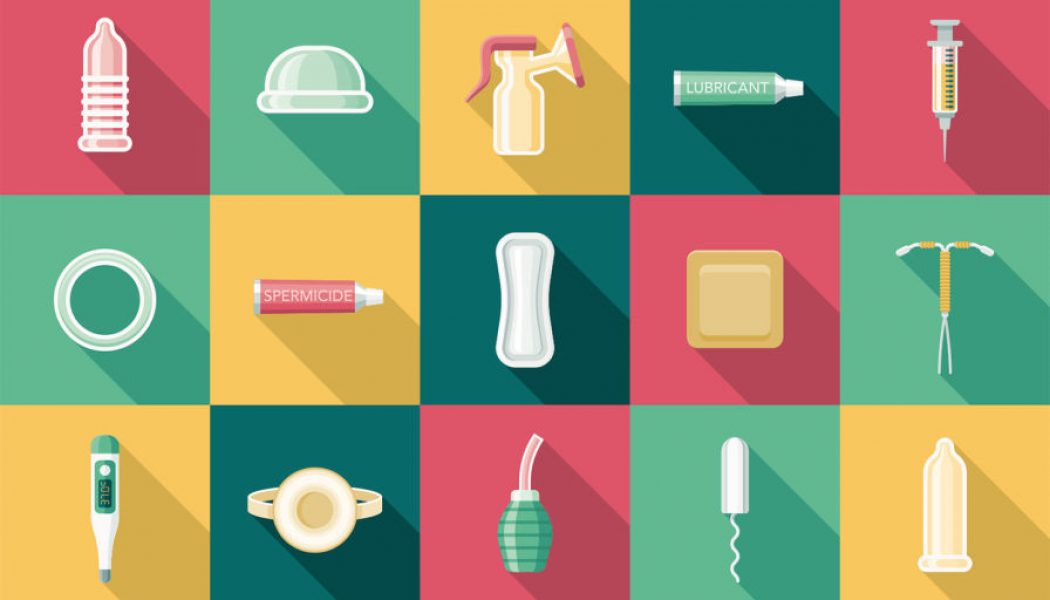The first time I had sex without a condom, I cried. It wasn’t that I regretted having condomless sex; I regretted not realizing I could have been doing it all along.
I’d opted myself out of hormonal birth control long before: I hated the hollowed-out, fatalistic feeling that enveloped me on the pill, and was perpetually skittish about both the pain that comes with IUD insertion and potential side effects. As a result, I never imagined myself having unprotected sex that I could deem safe. Conventional knowledge holds that medical birth control options—most notably, IUDs, and oral contraceptives—are the best pregnancy prevention tools for responsible women. Outside of condoms, effective alternatives to these medical interventions are generally considered to be nonexistent and are rarely made accessible. A desolate birth control landscape—coupled with the faulty premise that women are constantly at risk of pregnancy—meant that I spent years afflicted with a perpetual low-level anxiety around sex, deprived of the bodily autonomy that I subconsciously craved.
Ultimately, I found that no pill, intrauterine device, or ultra-ribbed piece of rubber “designed for [my] pleasure” alone could provide the sexual liberation I experience practicing a method most often publicly associated with anti-choice religious zealots: the fertility awareness method of birth control, or FAM.
By taking my temperature orally every morning, monitoring my body’s cervical fluid, and tracking my menstrual cycle, I gained the ability to identify my fertile window and use that information to make calculated sexual decisions. Having this information for the first time in my life made me strangely emotional: I suddenly had the power to use my body itself to prevent pregnancy rather than rely on tools with unclear mechanisms and maddening side effects, developed by predominantly male experts who stood to profit and made incrementally better over decades thanks to the laborious efforts of feminist activists. Through the process of learning and practicing fertility awareness as birth control, I developed trust in myself and fellow practitioners of effective natural methods, and my fear of the unknown fell away. I knew my body. I leaned on my community.
Women across the political spectrum are well aware of our limited, imperfect set of birth control tools. But for those of us on the left, criticizing our options can feel politically fraught: Medical contraceptives have long been considered emblems of sexual freedom and bodily autonomy, and today, they’re under siege by right-wing fundamentalists who seek to ensure women don’t have a modicum of power over our reproductive lives or the world around us.
This understandable fear can lead to outright hostility toward alternative methods, like FAM. Though it seems obvious to say that the right’s war on women is fought, too, by abstinence-only sex education (its corpse reanimated under the Trump administration as “sexual risk avoidance”), it is perhaps less obvious that such a curriculum explicitly pushes biological ignorance, depriving young people of the tools needed to understand their bodies—and fertility awareness—in the first place. In this way, right-wing attempts to keep young, unmarried people from having sex have only bolstered reliance on the medical birth control they themselves hope to render obsolete.
Lucy Ives alluded to this dynamic in The Baffler in November. Weaving in threads about her status as a fertility awareness user, she ultimately pinned blame on the Christian right for making FAM inaccessible, but left the role of good progressives and the medical field unexamined. We cannot absolve the left of responsibility: Under the guise of progressivism, many leftists embrace a patriarchal faith in technocracy and expertise that dismisses women’s anecdotal experience as illegitimate—unless that experience is captured in a scientific study with specific parameters.
‘; magazine_button_text_334898 = ‘‘; magazine_button_url_334898 = ‘https://www.thenation.com/email-signup-module-donate/’; magazine_button_bg_color_334898 = ‘#ffcf0d’; }else{ magazine_text_334898 = ‘
Subscribe today and Save up to $129.
‘; magazine_button_text_334898 = ‘‘; magazine_button_url_334898 = ‘https://ssl.drgnetwork.com/ecom/NAT/app/live/subscriptions?org=NAT&publ=NA&key_code=G9C1CAT&type=S’; magazine_button_bg_color_334898 = ‘#dd3333’; } if( magazine_text_334898 !=” ){ jQuery(“#magazine_text_334898″).html(magazine_text_334898); } if( magazine_button_text_334898 !=” ){ jQuery(“#magazine_button_334898″).html(magazine_button_text_334898); } if( magazine_button_url_334898 !=” ){ jQuery(“#magazine_button_334898 a”).attr(“href”,magazine_button_url_334898); } if( magazine_button_bg_color_334898 !=” ){ jQuery(“#magazine_button_334898 a input”).css(“background”,magazine_button_bg_color_334898); }
It’s time for an open discussion about so-called “natural” methods—and for the development of high-quality, accessible information around them.
In the spring of 2019, an FDA-approved fertility awareness app called Natural Cycles began advertising itself as birth control throughout the New York City subway system. Immediately, Twitter users went off about how unethical it is to call fertility awareness “birth control” and began poking fun at the asterisk resting next to the “effective” claim—as if the asterisk held an obvious secret all the good progressives knew, which is that obviously Natural Cycles didn’t work.
Some commentators online mistakenly, offhandedly labeled Natural Cycles’ version of fertility awareness “the rhythm method.” One Twitter user suggested that “if men could get pregnant,” ads on the subway promoting fertility awareness apps would be “illegal.” Another called marketing fertility awareness to the public “deranged and unsafe,” as though there isn’t a rich history of Big Pharma very publicly marketing tools like the Dalkon Shield—manufactured in the 1970s and pulled off shelves only because of a barrage of consumer lawsuits over pelvic infections, infertility, unintended pregnancies, miscarriage, and death, ultimately serving as the basis for one of the largest tort cases in history—to over 2.5 million women who would go on to use the device.
“Fertility apps like Natural Cycles claim to be birth control,” a 2018 Slate headline reads. “Don’t trust them.” It’s one thing for a marketed device to come under fire on Twitter, but the discourse around fertility awareness extends beyond the algorithms and into popular media: Consistently, writers read “fertility awareness” as code for the rhythm method. Writing about the Trump administration’s anti–birth control maneuvers in The Guardian, Jessica Valenti speaks of a plan “to teach teenagers ‘fertility awareness methods’—otherwise known as the rhythm method—in lieu of birth control.” In The Atlantic, Michelle Cottle deploys the same scare-quotes around fertility awareness—“you know, the rhythm method,” Cottle quips in a parenthesis.
‘; inline_cta_font_color_334898 = ‘#000000’; inline_cta_button_text_334898 = ‘‘; inline_cta_url_334898 = ‘https://www.thenation.com/donate-website/?sourceid=1020084’; inline_cta_bg_color_334898 = ‘#ffcf0d’; }else{ inline_cta_text_334898 = ‘
Support Progressive Journalism
If you like this article, please give today to help fund The Nation’s work.
‘; inline_cta_font_color_334898 = ‘#000000’; inline_cta_button_text_334898 = ‘‘; inline_cta_url_334898 = ‘https://www.thenation.com/donate-website/?sourceid=1020084’; inline_cta_bg_color_334898 = ‘#ffcf0d’; } if( inline_cta_text_334898 !=” ){ jQuery(“#inline_cta_334898″).html(inline_cta_text_334898); cta_1_check_334898 = true; } if( inline_cta_button_text_334898 !=” ){ jQuery(“#inline_cta_btn_334898″).html(inline_cta_button_text_334898); cta_1_check_334898 = true; } if( inline_cta_url_334898 !=” ){ jQuery(“#inline_cta_btn_334898 a”).attr(“href”,inline_cta_url_334898); cta_1_check_334898 = true; } if( inline_cta_bg_color_334898 !=” ){ jQuery(“#inline_cta_btn_334898 a input”).css(“background”,inline_cta_bg_color_334898); cta_1_check_334898 = true; } if( inline_cta_font_color_334898 !=” ){ jQuery(“#inline_cta_btn_334898 a input”).css(“color”,inline_cta_font_color_334898); cta_1_check_334898 = true; } if( cta_1_check_334898 ){ jQuery(“#inline_cta_1_module_334898”).addClass(“tn-inline-cta-module”); }
I began weaving fertility awareness into my conversations, trying to gauge awareness and interest among my peers. For many, the functionality of FAM as birth control seemed an open secret: One friend shared that she used a well-known method of fertility awareness for three years, at a time in her life when no other method was quite right. For others, it was a revelation: Eyes widened, information was devoured, and IUD removals were plotted. Rarely did I feel stigmatized by friends or colleagues in the reproductive health space; rather, I witnessed such stigma primarily online, in feminist and progressive media, and in medical communities.
While the political fear and anger at the heart of the fertility awareness backlash are natural, they nevertheless reinforce the belief that doctors are both gods and the gatekeepers of fertility. This fear also cuts women off from life-changing alternatives and quality information about our health. Reliance on hormonal birth control and long-acting reversible contraceptives has gradually dispossessed us of direct knowledge and understanding of our cycles: commodifying our fertility, automating pregnancy prevention, and selling the promise of sexual freedom back to us in faux-feminist packaging.
I now earnestly believe it is a mistake for leftists to not support access to functional, knowledge-based, low-cost tools like FAM—especially when the alternatives are pills and devices fraught with potential complications and that aren’t even universally available. Widespread fertility awareness knowledge would allow for the creation of a more democratic and decentralized model of information and technology ownership, removing gatekeeping power from the hands of medical providers, rebuffing the pharmaceutical industry, and restoring self-knowledge and strength through solidarity among practitioners.
For the uninitiated, fertility awareness-based methods (FABMs) are tools used to prevent pregnancy, achieve pregnancy, or generally gain better control of one’s reproductive health by monitoring physical indicators that help users identify their fertile window. During the fertile window, those using FABMs to prevent pregnancy may add in barrier methods, rely on withdrawal, or take a break from traditionally heterosexual, penetrative sex. (I personally opt for withdrawal with a trusted partner—a method considered 96 percent effective with perfect use.)
Some key physical indicators of where you are in your cycle are menstruation, basal body temperature (your temperature when you first wake up in the morning, abbreviated as BBT), and cervical fluid presence and quality. Taken together, these indicators form a category of FABMs known as symptothermal methods—with the potential to be highly effective forms of birth control. When I speak personally about “using FAM,” I’m referring to the method outlined in Toni Weschler’s 1995 book, Taking Charge of Your Fertility—one of the most famous secular FABMs in existence.
Though fertile windows vary, most estimates suggest people who ovulate are capable of getting pregnant on only about six days per cycle. Young people are often taught that it’s impossible to know exactly when this happens, so unless you’re trying to get pregnant, you should use a barrier method or other form of medical birth control every time you have sex. As a result, many of us operate with the false assumption that we are constantly vulnerable to pregnancy—and should behave as such.
By this logic, our bodies are inherently unruly and in need of correction and control. This notion is psychologically taxing, fuels sex anxiety, and saddles us with the responsibility for preventing pregnancy at all costs. Women who don’t use medical birth control are deemed irresponsible. As a result, medical birth control options have become so ubiquitous among certain populations of women that the idea of preventing pregnancy without them seems—literally—impossible. I know condom users in long-term, monogamous, heterosexual partnerships who also use medical birth control—just to be extra safe. It’s this creation by birth control of a categorical “safe” sex that creates the accompanying antithesis that is a clearly delineated “unsafe” sex.
Of course, medical birth control options are still and always will be vital. Fertility awareness is not a functional practice for everyone, especially those who experience painful menstruation or who travel frequently and would struggle to take their temperature at the same time daily.
But many of the arguments against FAM—that it’s not good for people who aren’t in sexually monogamous relationships or that it “won’t work” for people with irregular cycles—are based more in stigma and misinformation than data. Practicing fertility awareness doesn’t mean swearing off condoms, and the best forms of fertility awareness don’t rely on reflecting past cycles to predict future cycles; rather, users rely on the gathering of daily data to make informed decisions. Being a practitioner doesn’t even mean you necessarily rely on this data as birth control: During periods of sexual non-monogamy, I’ve opted to use condoms while still maintaining my temp-tracking ritual and fertility chart.
‘; inline_cta_2_font_color_334898 = ‘#ffffff’; inline_cta_2_button_text_334898 = ‘‘; inline_cta_2_url_334898 = ‘https://ssl.drgnetwork.com/ecom/NAT/app/live/subscriptions?org=NAT&publ=NA&key_code=68F1CGS&type=S’; inline_cta_2_bg_color_334898 = ‘#cc0e0e’; }else{ inline_cta_2_text_334898 = ‘
Subscribe to The Nation for $2 a month.
Get unlimited digital access to the best independent news and analysis.
‘; inline_cta_2_font_color_334898 = ‘#ffffff’; inline_cta_2_button_text_334898 = ‘‘; inline_cta_2_url_334898 = ‘https://ssl.drgnetwork.com/ecom/NAT/app/live/subscriptions?org=NAT&publ=NA&key_code=G8F1CTA&type=S’; inline_cta_2_bg_color_334898 = ‘#cc0e0e’; } if( inline_cta_2_text_334898 !=” ){ jQuery(“#inline_cta_2_334898″).html(inline_cta_2_text_334898); cta_2_check_334898 = true; } if( inline_cta_2_button_text_334898 !=” ){ jQuery(“#inline_cta_2_btn_334898″).html(inline_cta_2_button_text_334898); cta_2_check_334898 = true; } if( inline_cta_2_url_334898 !=” ){ jQuery(“#inline_cta_2_btn_334898 a”).attr(“href”,inline_cta_2_url_334898); cta_2_check_334898 = true; } if( inline_cta_2_bg_color_334898 !=” ){ jQuery(“#inline_cta_2_btn_334898 a input”).css(“background”,inline_cta_2_bg_color_334898); cta_2_check_334898 = true; } if( inline_cta_2_font_color_334898 !=” ){ jQuery(“#inline_cta_2_btn_334898 a input”).css(“color”,inline_cta_2_font_color_334898); cta_2_check_334898 = true; } if( cta_2_check_334898 ){ jQuery(“#inline_cta_2_module_334898”).addClass(“tn-inline-cta-module”); }
If feminism’s goal is to give women more choice and freedom from the capital-fueled, patriarchal chains that bind us, the feminist case for fertility awareness is self-evident.
I became my own FAM guinea pig with a foundation of information from a few trusted women. I didn’t want to get pregnant, but one gender studies degree and two years of working at a reproductive health nonprofit later, I felt totally comfortable with the possibility of getting an abortion—and, critically, could afford one if necessary.
That’s not the case for everyone, but all sex involves some kind of risk—and ideally, it’s calculated and taken freely with informed consent.
Going into my experiment, I knew the empirical data around FAM was lacking relative to other methods, but my misadventures with medical birth control had left me personally uncomfortable about ever reentering that world. Two bouts on the pill coincided with two bouts of wanting to die; I was assured by doctors both times that the particular cocktails of hormones (“low dose”) would not impact my mental health. Because I trusted my providers and wanted deeply to be on birth control, I tried desperately to convince myself that the pill was not to blame for my constant weeping, inability to get out of bed, and frequent snaps at loved ones.
I knew and still know it’s possible that my depression was caused by factors unrelated to pills—but twice, quitting combined oral contraceptives allowed me to get my head above water and breathe again. Even the tiniest risk of putting myself through that once more would never be worth it. As a result, I relied on condoms; my experiences left me hesitant about using any medical device with unclear mechanisms to alter my body, my one and only lifelong habitat. I wanted alternatives.
Feeling let down by my prescribing gynecologists, I decided to place trust in the unlicensed women in my life. And unlike during my trials with oral contraceptives, I fully understood the risks of unprotected sex. In other words: I consented.
To be clear, I’m not arguing that medical options aren’t crucial tools that should be freely available. Birth control access is under siege by right-wing forces and deserves a full-throated defense. Any critique of mainstream birth control options or positing of alternatives should not be construed as an argument against accessibility.
But medical birth control tools—and our medical system at large—are flawed, with material negative effects. Discouraging women from seeking alternatives to medical intervention is cruel and paternalistic, and doctors and researchers who use science as a cudgel against curiosity, anecdotal experience, and community are repressive and reductive. Throughout history, women have had to speak up for their health and well-being to bring about any change at all; the increasing presence and authority of women in medicine hasn’t changed the necessity of this process.
It’s critical for us to have access to all of our options, and an understanding of what they are. Any medical birth control tools advanced primarily by men under capitalism can’t be value-neutral (if they were, perhaps more men would be forced to shoulder the burden of pills packed with side effects). But in this world, women are primarily held responsible—with many of us led to believe that every worthwhile option is pharmaceutical in nature. That’s not true. And we deserve the space to talk about it—publicly and with our peers.
When most people think of fertility awareness, they imagine woo-woo, unscientific, or religiously fueled practices like the rhythm method, a mistake that both conflates comprehensive cycle-tracking with far less effective practices and stigmatizes users in the same breath. This assumption pits responsible, intelligent birth control users who take their birth control pills against the classist cliché of reckless, uneducated future mothers or abortion patients. It also enforces another left-right divide: that between the educated, secular left and the ignorant, religious right.
In actuality, the world of FABMs is complex and science-based, encompassing a litany of methods. The most comprehensive systematic review of the existing literature—conducted in part by Guttmacher’s Dr. Chelsea Polis and now cited by the CDC—identifies 14 distinct FABMs across 53 prospective studies, each with more than 50 participants. The review breaks criteria-meeting FABMs down into five categories of method: calendar, mucus-only, basal body temperature–plus (a mixture of temperature, menstrual length tracking, and optional urinary hormone measurement), symptothermal (cervical mucus, temperature, and optional menstrual length tracking and cervical position tracking), and urinary hormone based (or symptohormonal), which involves tracking urinary hormones, cycle length, and, in some cases, cervical mucus.
Relative to mainstream medical birth control, the data available for these methods is a pittance: Zero of the studies met the bar to be classified by the review’s researchers as “high quality,” though 21 at least earned the “moderate quality” rating. The rest: low.
Data on Weschler’s method—again, the fertility awareness method I use and one of the most famous methods in the Western world—could not be captured by the review’s thoughtful methodology. According to Dr. Polis, there are zero clinical studies on Weschler’s specific method. This is, to be frank, shocking: In 2010, Taking Charge was ranked higher on Amazon than every other book—except the third and fourth volumes of Harry Potter. It’s currently the number-one best seller on Amazon in obstetrics and gynecology. The 20th anniversary edition boasts 4.8 stars with nearly 600 reviews on Amazon and 4.52 stars with 8,093 ratings on Goodreads. Combing through reviews on both sites, one sees that it is commonly labeled “the Bible for women.”
Still, no scientific research has examined exactly how effective it is.
Nevertheless, the systematic review cited by the CDC shows that existing research on comparable FABMs is promising, though this comes with important caveats given the limited extent and quality of existing data. The Sensiplan symptothermal method—which has a lot in common with Weschler’s—boasts an estimated typical use failure rate of 2 percent and 0.4-0.6 percent with perfect use. (For context: Numerous studies in more generalizable populations suggest that oral contraceptives have a 7 percent typical use failure rate and a 0.3 percent perfect use failure rate; condoms, 13 percent typical use and 2 percent perfect use; and hormonal IUDs, 0.1-0.4 percent typical use and 0.1-0.3 percent perfect use.)
A handful of other FABMs only had typical use failure rates available, including the maligned Natural Cycles app, which requires users to input fertility indicators daily and uses an algorithm to calculate the fertile window. A moderate-quality study of the app plotted at a 10 percent typical use failure rate in the systematic review and now boasts a 2 percent perfect use failure rate. Moderate quality research on the Marquette method (which requires urinary hormone testing kits, making it a cost-prohibitive method for most people) claims a 2 to 7 percent failure rate with typical use—and zero percent failure with perfect use.
Yet fertility awareness is still widely denounced and mislabeled among leftists and advocates in the reproductive health space.
“You know what we call people who practice the rhythm method?” Cecile Richards tweeted in 2017. “Parents.”
The tendency among certain segments of the left to refuse critical appraisal of our tools makes us willfully ignorant of how they change our lives and, at times, harm us. The values inherent in our most popular birth control options reinforce modern ideas about how women should live and operate—ambitiously and productively (“Who has time for a period?”)—establishing traditionally masculine biology as normative, shutting down people who want to retain their cycles, and bolstering respect for the relentless pursuit of work.
After all: It’s easier for feminists to accept a 60-hour workweek if we call it women’s liberation.
Within the liberal paradigm that nurtures contemporary ideas about sex, efficacy in pregnancy prevention is the only real criterion for good birth control—side effects be damned—and is tightly entwined, of course, with a desire to eradicate any room for user error. In the efficacy-at-all-costs framework, we are handed the option of automation, told to pay no mind to how our bodies work, and place faith in devices developed by scientists who do. Side effects and (debatably) blissful ignorance are just the price we are expected to pay for anxiety-free sex.
Only it’s not truly anxiety-free. Consensual sex always demands calculated risk—and in addition to establishing structures to provide universal, free access to abortion, a more expansive notion of informed consent would require us to democratize the tools for making those calculations.
It’s also true that in all current worlds, men have the luxury of not taking pills riddled with side effects or becoming experts on their own bodies. And for many of us, a fix-it-and-forget-it solution is currently the only reasonable option; in this political and cultural moment, practicing fertility awareness is a privilege.
As it stands, most birth control options are filtered through health care providers with their own technological biases and profit motives. Providers are also incredibly busy—it’s virtually impossible to expect every provider to know and share the nuances of each and every method of birth control, let alone each possible fertility awareness method—and though the scientific and medical communities are open to changing when compelled by evidence, it’s a very, very slow-moving ship. Funding for contraceptive research is hard to come by, and gaining a hypothetical wealth of high-quality data on the effectiveness of over a dozen FABMs will take time, energy, and a lot of money. Per a 2013 Guttmacher report on funding for contraceptive research, new drug discovery and development is primarily led by the private sector, with large pharmaceutical and biotech companies’ having largely abandoned contraceptive development “given the popularity and profitability of the birth control pill.” Public and philanthropic dollars funneled toward contraceptive technology research have also significantly declined in recent decades. When our options for funders are either profit-driven or paternalistic, we’re left high and dry.
We need an ambitious, honest plan for democratizing fertility knowledge that reconciles the limitations of research systems with our need for better birth control information within our lifetimes. That includes funneling more money toward research around natural methods and advocating for a broader understanding of health care outside of existing technological interventions.
The price is high: It is our health and our lives. Community knowledge, now, is key. I attribute much of my success in using FAM to having a friend who has practiced for over five years; being able to ask her questions has been invaluable.
But not everyone has access to that kind of resource. And negotiating how to talk about FABMs publicly—being honest about how empowering and functional I’ve found a practice that isn’t sanctioned by many providers—means walking a fine line between worshipping at the altar of empirical data and undercutting it, potentially risking the respect of my colleagues in the reproductive health space.
The technological model of health care is not unassailable. Even as it has given us options, it has taken others away. Ultimately, we deserve access to information about our bodies—and we deserve to be heard.
In the words of Barbara Seaman, a champion of informed consent who famously protested the 1970 birth control pill hearings presided over entirely by men: “Some women want to let their doctors do the worrying for them. For those of us who don’t, it has been difficult to get honest health information.” Fifty years later, we’re still fighting just to have the option to make these decisions ourselves.









